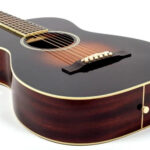“Stand By Me” by Ben E. King is a timeless classic, and it’s also an excellent choice for beginner guitarists. Its simple yet beautiful chord progression makes it one of the first songs many guitar players learn. If you’re just starting your guitar journey, mastering the guitar chords to “Stand By Me” is a fantastic way to build your skills and learn a song you’ll love to play. This lesson will break down the easy guitar chords you need and get you strumming along in no time.
Mastering the Basic Guitar Chords: G, Em, C, and D
The magic of “Stand By Me” lies in its four fundamental chords: G major, E minor (Em), C major, and D major. These are common chords in countless songs, making them essential building blocks for any guitarist. Let’s take a quick look at each:
-
G Major: This is often one of the first chords beginners learn. You can finger it in a few ways, but a common method is placing your middle finger on the 6th string (low E string), 3rd fret, your index finger on the 5th string (A string), 2nd fret, and your ring finger on the 1st string (high E string), 3rd fret.
-
E Minor (Em): Em is a slightly melancholic sounding chord and is very easy to transition to from G. Simply keep your middle finger on the 6th string, 3rd fret, and lift off your other fingers. Alternatively, place your middle finger on the 5th string (A string), 2nd fret and your ring finger on the 4th string (D string), 2nd fret.
-
C Major: C major brings a brighter tone to the progression. Place your ring finger on the 5th string (A string), 3rd fret, your middle finger on the 4th string (D string), 2nd fret, and your index finger on the 2nd string (B string), 1st fret.
-
D Major: D major provides a strong resolution in this chord sequence. Place your index finger on the 3rd string (G string), 2nd fret, your middle finger on the 1st string (high E string), 2nd fret, and your ring finger on the 2nd string (B string), 3rd fret.
Alt text: Guitar chord diagram illustrating the finger positions for G Major chord, a fundamental chord in “Stand By Me”.
Alt text: Guitar chord diagram showing the finger placement for E minor chord, a key chord for playing “Stand By Me” on guitar.
Alt text: Instructional guitar chord diagram for C Major, essential for beginners learning “Stand By Me” chords.
Alt text: Beginner-friendly guitar chord diagram for D Major, one of the four chords needed to play “Stand By Me”.
Simple Strumming Pattern for Beginners
For “Stand By Me”, a straightforward strumming pattern works perfectly. A down-mute strum is a great starting point. This involves a down strum followed by a slight muting of the strings with your strumming hand, then another down strum and mute. It’s often written as: Down – Mute – Down – Mute. Focus on keeping a steady rhythm and let the natural syncopation of the pattern emerge. You can practice this strumming pattern on each chord individually before putting them together.
Playing Through “Stand By Me”
The core of “Stand By Me” uses this chord progression repeatedly: G – Em – C – D. Each chord is typically played for four beats (or counts). So, you would strum the G chord for four counts, then switch to Em for four counts, then C for four counts, and finally D for four counts, before returning to G and repeating the sequence. This simple progression forms the verse and much of the chorus of the song.
There’s a slight variation at the end of the chorus where, instead of going from G back to Em, you go from G to D and hold the D chord for a few extra beats. This creates a nice resolution before the progression starts again.
Adding a Simple Guitar Lick (Optional)
While the chords and strumming are the heart of “Stand By Me”, you can add a cool little guitar lick to spice things up as you progress. This lick isn’t too difficult and provides a nice melodic element. It utilizes notes on the low E string and incorporates the chords you’ve already learned.
[Guitar Tab for Simple Lick]
e|———————————|
B|———————————|
G|———————————|
D|———————————|
A|———————————|
E|-0-2-3-3—0-2-3-3—5-5—7-7—|
Tab: e| – high E string, B| – B string, G| – G string, D| – D string, A| – A string, E| – low E string. Numbers represent fret numbers. 0 means open string.
This tab shows a simplified lick that you can play over the chord progression. It starts on the open low E string (0), then moves to the 2nd fret (F#) and 3rd fret (G) before hitting the G chord. The pattern repeats and then moves to notes that fit over the C and D chords. This lick is a great way to start exploring melody and lead guitar within the context of “Stand By Me”.
Alt text: Example of guitar tablature for a simple lick, illustrating a melodic phrase that can be played with “Stand By Me” chords.
Conclusion: Stand By Your Guitar and Keep Practicing!
Learning the guitar chords to “Stand By Me” is a rewarding step for any beginner guitarist. With just four easy chords and a simple strumming pattern, you can play this iconic song. Don’t be afraid to take it slow, practice each chord transition, and gradually build up your speed and strumming fluency. And if you’re feeling adventurous, try adding that little guitar lick. Keep practicing, and you’ll be playing “Stand By Me” for yourself and others in no time. Happy playing!

